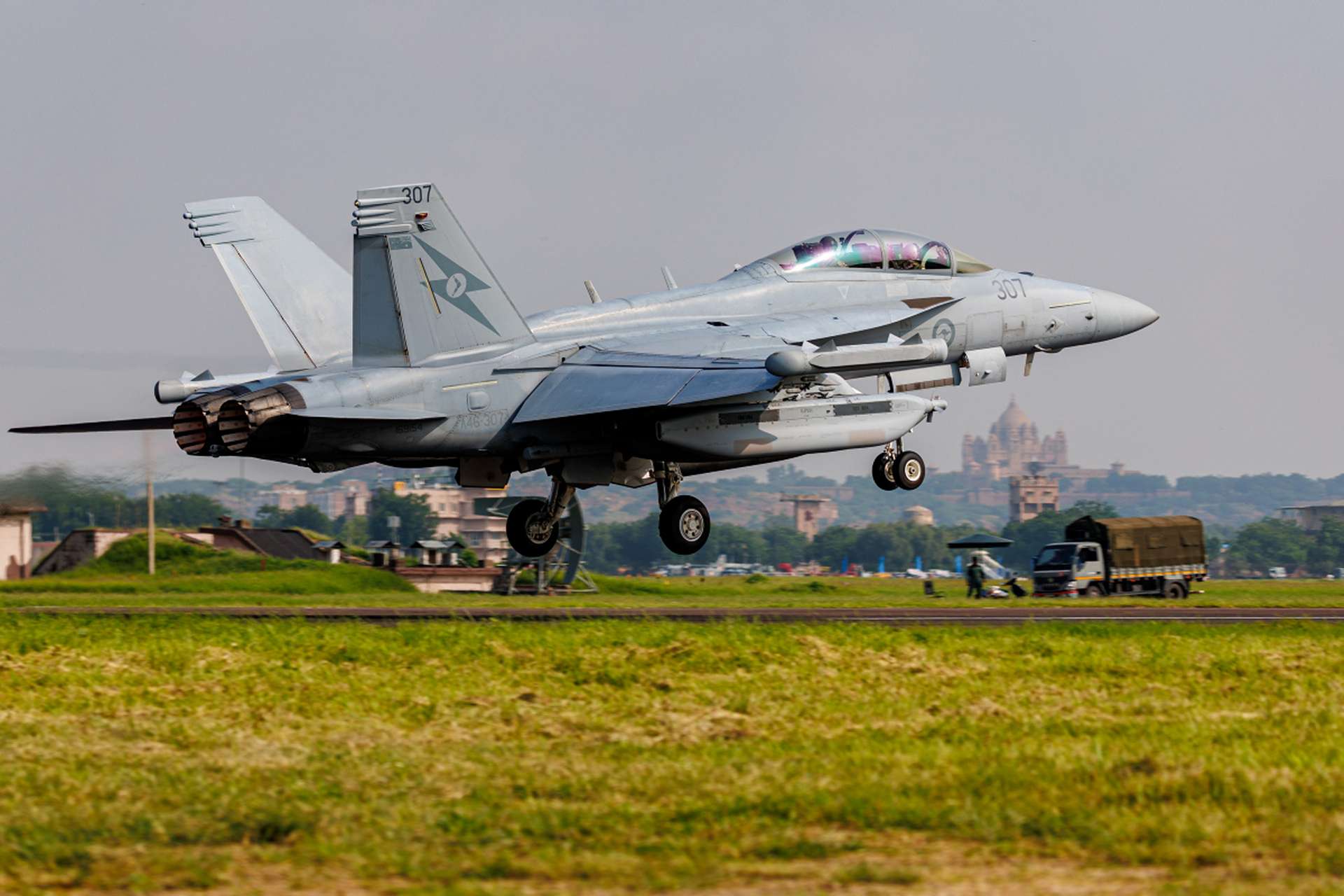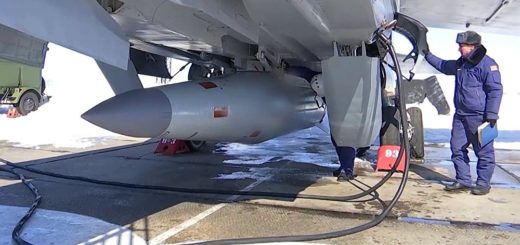Royal Australian Air Force Participates for First Time in Combat Aircraft Training in India with EA-18G Growler Fighter Jets

{loadposition bannertop}
{loadposition sidebarpub}
On September 29, 2024, the Royal Australian Air Force (RAAF) confirmed its participation in the multinational exercise Tarang Shakti, held in Jodhpur, India. This marks the first time the RAAF has sent its EA-18G Growler fighter jets to India for combat training. Organized by the Indian Air Force (IAF), the exercise involved eight participating nations and 18 observer countries. The deployment of the Growlers highlights the strengthening of defense cooperation between Australia and India, as well as Australia’s broader commitment to regional security in the Indo-Pacific.Follow Army Recognition on Google News at this link
Royal Australian Air Force Participates at the Multinational Exercise Tarang Shakti in India (Picture source: Australian MoD)
Three Boeing EA-18G Growler electronic warfare aircraft and 120 Royal Australian Air Force personnel from the 6th Squadron were deployed for the exercise. This marks the first time Australia has sent combat aircraft for training in India, highlighting the deepening of bilateral defense relations and the commitment to strengthening security in the Indo-Pacific region.
According to the Military Balance 2024, the Royal Australian Air Force currently operates 11 EA-18G Growlers. These aircraft, specialized in electronic warfare and capable of jamming enemy air defense systems, play a central role in Australia’s air strategy. Their deployment in the Tarang Shakti exercise demonstrates Australia’s intent to actively participate in regional security initiatives while enhancing its operational capabilities.
The Tarang Shakti exercise, which is held every two years, took place in two phases in 2024. The first phase, from August 6 to 14, occurred at the Sulur Air Base in the state of Tamil Nadu, involving several European nations, including France, Germany, Spain, and the United Kingdom. The second phase, held in Jodhpur from August 30 to September 14, featured participants from Asia and the Pacific, including Australia, Japan, Singapore, Greece, the United Arab Emirates, and the United States.
This exercise is becoming increasingly important in the regional context, where Australia and India are strengthening their influence in defense matters. The strategic partnership between these two nations is reflected in their shared commitment to deepening the complexity of joint exercises while ensuring stability in a region facing growing geopolitical tensions.
Military cooperation between Australia and India has significantly strengthened in recent years. This relationship has been solidified through key agreements such as the 2009 Joint Declaration on Security Cooperation and the signing of the Mutual Logistics Support Agreement in 2020, facilitating joint military operations. The geostrategic importance of the Indian Ocean, vital for global trade and energy security, remains central to this partnership.
Australia’s participation in the AUSINDEX exercise, coupled with China’s growing power in the region, has prompted Canberra and New Delhi to intensify their military cooperation. In response to China’s territorial claims in the South China Sea and the expansion of its naval capabilities in the Indian Ocean, the two nations are aligning to ensure maritime security. However, India, adhering to its policy of non-alignment, remains cautious about formal military commitments.
The Boeing EA-18G Growler, an electronic warfare aircraft derived from the F/A-18F Super Hornet, is a cornerstone of Australia’s air defense. Designed to replace the U.S. Navy’s Grumman EA-6 Prowler, this aircraft is equipped with advanced electronic warfare systems provided by Northrop Grumman, capable of jamming radars and neutralizing enemy air defense systems.
In 2008, the RAAF ordered six EA-18G Growlers as part of a broader acquisition of 24 F/A-18F Super Hornets. In 2012, the order evolved, with 12 of these aircraft being converted into EA-18Gs, thus enhancing Australia’s electronic warfare capabilities for a total cost of 1.5 billion Australian dollars. The first aircraft was delivered in June 2014, with a model officially presented in July 2015.
The technical specifications of the EA-18G Growler make it a major strategic asset: with a length of 18.3 meters and a wingspan of 13.7 meters, it is powered by two F414-GE-400 engines, providing a total thrust of 44,000 pounds. The aircraft can carry up to 6,323 kg of internal fuel and an additional 4,420 kg in external tanks. Its crew consists of a pilot and a weapons systems officer, ensuring high mission efficiency.
Royal Australian Air Force EA-18G Growler Fighter Jet in India (Picture source: Australian MoD)

{loadposition bannertop}
{loadposition sidebarpub}
On September 29, 2024, the Royal Australian Air Force (RAAF) confirmed its participation in the multinational exercise Tarang Shakti, held in Jodhpur, India. This marks the first time the RAAF has sent its EA-18G Growler fighter jets to India for combat training. Organized by the Indian Air Force (IAF), the exercise involved eight participating nations and 18 observer countries. The deployment of the Growlers highlights the strengthening of defense cooperation between Australia and India, as well as Australia’s broader commitment to regional security in the Indo-Pacific.
Royal Australian Air Force Participates at the Multinational Exercise Tarang Shakti in India (Picture source: Australian MoD)
Three Boeing EA-18G Growler electronic warfare aircraft and 120 Royal Australian Air Force personnel from the 6th Squadron were deployed for the exercise. This marks the first time Australia has sent combat aircraft for training in India, highlighting the deepening of bilateral defense relations and the commitment to strengthening security in the Indo-Pacific region.
According to the Military Balance 2024, the Royal Australian Air Force currently operates 11 EA-18G Growlers. These aircraft, specialized in electronic warfare and capable of jamming enemy air defense systems, play a central role in Australia’s air strategy. Their deployment in the Tarang Shakti exercise demonstrates Australia’s intent to actively participate in regional security initiatives while enhancing its operational capabilities.
The Tarang Shakti exercise, which is held every two years, took place in two phases in 2024. The first phase, from August 6 to 14, occurred at the Sulur Air Base in the state of Tamil Nadu, involving several European nations, including France, Germany, Spain, and the United Kingdom. The second phase, held in Jodhpur from August 30 to September 14, featured participants from Asia and the Pacific, including Australia, Japan, Singapore, Greece, the United Arab Emirates, and the United States.
This exercise is becoming increasingly important in the regional context, where Australia and India are strengthening their influence in defense matters. The strategic partnership between these two nations is reflected in their shared commitment to deepening the complexity of joint exercises while ensuring stability in a region facing growing geopolitical tensions.
Military cooperation between Australia and India has significantly strengthened in recent years. This relationship has been solidified through key agreements such as the 2009 Joint Declaration on Security Cooperation and the signing of the Mutual Logistics Support Agreement in 2020, facilitating joint military operations. The geostrategic importance of the Indian Ocean, vital for global trade and energy security, remains central to this partnership.
Australia’s participation in the AUSINDEX exercise, coupled with China’s growing power in the region, has prompted Canberra and New Delhi to intensify their military cooperation. In response to China’s territorial claims in the South China Sea and the expansion of its naval capabilities in the Indian Ocean, the two nations are aligning to ensure maritime security. However, India, adhering to its policy of non-alignment, remains cautious about formal military commitments.
The Boeing EA-18G Growler, an electronic warfare aircraft derived from the F/A-18F Super Hornet, is a cornerstone of Australia’s air defense. Designed to replace the U.S. Navy’s Grumman EA-6 Prowler, this aircraft is equipped with advanced electronic warfare systems provided by Northrop Grumman, capable of jamming radars and neutralizing enemy air defense systems.
In 2008, the RAAF ordered six EA-18G Growlers as part of a broader acquisition of 24 F/A-18F Super Hornets. In 2012, the order evolved, with 12 of these aircraft being converted into EA-18Gs, thus enhancing Australia’s electronic warfare capabilities for a total cost of 1.5 billion Australian dollars. The first aircraft was delivered in June 2014, with a model officially presented in July 2015.
The technical specifications of the EA-18G Growler make it a major strategic asset: with a length of 18.3 meters and a wingspan of 13.7 meters, it is powered by two F414-GE-400 engines, providing a total thrust of 44,000 pounds. The aircraft can carry up to 6,323 kg of internal fuel and an additional 4,420 kg in external tanks. Its crew consists of a pilot and a weapons systems officer, ensuring high mission efficiency.

Royal Australian Air Force EA-18G Growler Fighter Jet in India (Picture source: Australian MoD)





